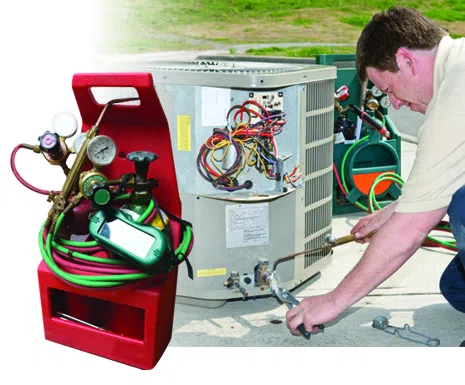An average contractor could spend tens of thousands to launch energy performance contracting, but the profit potential makes it worth the investment.
As with anything else, energy performance contracting has a cost. That being said, performance contracting can be a huge profit center.
Each HVACR company will implement performance contracting in its own way based on how it is going to offer the services; who is going to perform the tests; and who is going to repair the problems found.
Certain instruments are needed, and if you are taking part in a program offering rebates or low-interest loans, certain test instruments could be required.
Blower doors: Measure the tightness of a structure and answer the age-old question in a load calculation: What is the infiltration rate of the building? There are two styles of blower doors: hard panel and cloth panel. Both are excellent for measuring the building; however, the hard-panel style goes up quicker, looks better to customers, and is preferred by many. Prices range from $2,550 to $4,995, with the hard panels being at the upper end. Both include digital two-channel manometers, and depending on the price, could include carrying cases.
Infrared cameras: A critical visual tool for both the customer and the contractor. They unequivocally demonstrate the state of an existing or new HVAC system: missing insulation, thermal bypasses, and even duct leakage in the right situation.
When it comes to cameras, it’s all about resolution and sensitivity. The more money you spend, the better these will be. Other potential built-in features include digital cameras, alarms, and even wi-fi for mobile-device compatibility. Cameras range from $1,995 to $7,495, with the sweet spot being in the middle.
Air capture hoods: Used to air balance duct systems, measuring airflow; and, if used with a blower, can help in the measurement of duct leakage. (However, they cannot measure duct leakage on their own.) There are different sizes of tents and different ranges of CFM measurements. You will eventually need a couple. They range in price from $1,490 to $2,500 for the basics. Other options can be added that would drive the cost up.
Duct air tightness testers: These measure duct leakage, and also can be used as a powered flow hood (difficult). A program for testing in and out for quality control could require them; however, I believe that they are a great tool for the repair crew. They can see where they start, and then validate at the end of the repair, eliminating the need for another trip for someone else to verify. They range from $1,650 to $1,795 and include their own digital manometer. I do not recommend getting one while thinking you can use your blower door manometer. This eliminates the ability of the repair, eliminating the need for another trip for someone else to verify. They range from $1,650 to $1,795 and include their own digital manometer. I do not recommend getting one while thinking you can use your blower door manometer. This eliminates the ability burns gas and/or oil. These range from $400 to $1,350, with additional options such as printers and probes that also add to the cost.
Static pressure gauge kits: Not a requirement, but a must in my opinion before sealing duct systems. (It may have worked only because it leaked.) Sealing could drastically raise the static pressure and could lower air flow, raise utility costs, and damage HVAC equipment. Kits range from $250 to $265. Make sure your kit includes probes and tubing, and just not a gauge. I also prefer digital to analog.
Gas leak detectors: Used to check leakage in gas pipe connections fittings and HVAC equipment. They range from $120 to $850, depending on different features in the unit. These are a requirement for any program being offered.
Personal CO monitor: Clipped to a belt, these will allow you to know if low levels of CO are present in the home. These range $220 to $240.
Certifications: All programs that offer rebates and/or low interest loans will require certification. The most common is BPI, which offers many; however, the two that commonly are required are the (BA) Building Analyst and the (EP) Envelope Professional. Courses run on average from $1,250 to $1,500 per stu- dent, plus the cost of each written exam at $225 to $250 each. Additionally, a field exam is required, with an exam cost again of $225 to $250, plus the cost of the proctor.
Depending on whether he travels or the student travels, and how many certifications are being proctored, this can run from $600 to $1,500 per student.
An average company will invest anywhere from $15,000 to $30,000 into getting started, depending on how many people they get certified and/or trained in performance contracting.
Just buying test instruments and getting certified does not mean a contractor will be able to repair homes. Most training teaches you how to pass the exams; however, that does not mean you know how to find the problem, repair the problem, and sell the solutions.
A common complaint I hear is, We tested the home, and it failed. Now what? Make sure when partnering with a performance training partner that they offer training in marketing and sales systems.
As I stated earlier, while there is a cost to get going, there also is a profit benefit to the contractor. We hear that the average increase in closing ratios goes up by 10% to 15% when these tools are used. Add-on sales also are very common and can range from $1,000 to $5,000. In addition, you can covert IAQ leads (duct cleaning, high-efficiency filters, etc.) into performance evaluations, and these can be very profitable.
Also, callbacks can be reduced and even lead costs go down by mining your own customer base, asking for referrals, and becoming known as a true problem solver.
As a final note, most performance contractors will charge for testing. I see these range from under $100 to as high as $650. My suggestion is to charge enough to get rid of tire kickers but don’t charge so much that you cannot get into homes. I always like to say that there is no money in testing; the profit comes from repairing and fixing homes and ducts. Additionally, even if you are not on an equipment sales call, sometimes it will turn into one.
The industry has changed. Homeowners are asking for energy performance contracting, some areas require it, and many areas have rebates or low-interest loans available. Don’t let the small investment hold you back from becoming an energy performance contractor!


